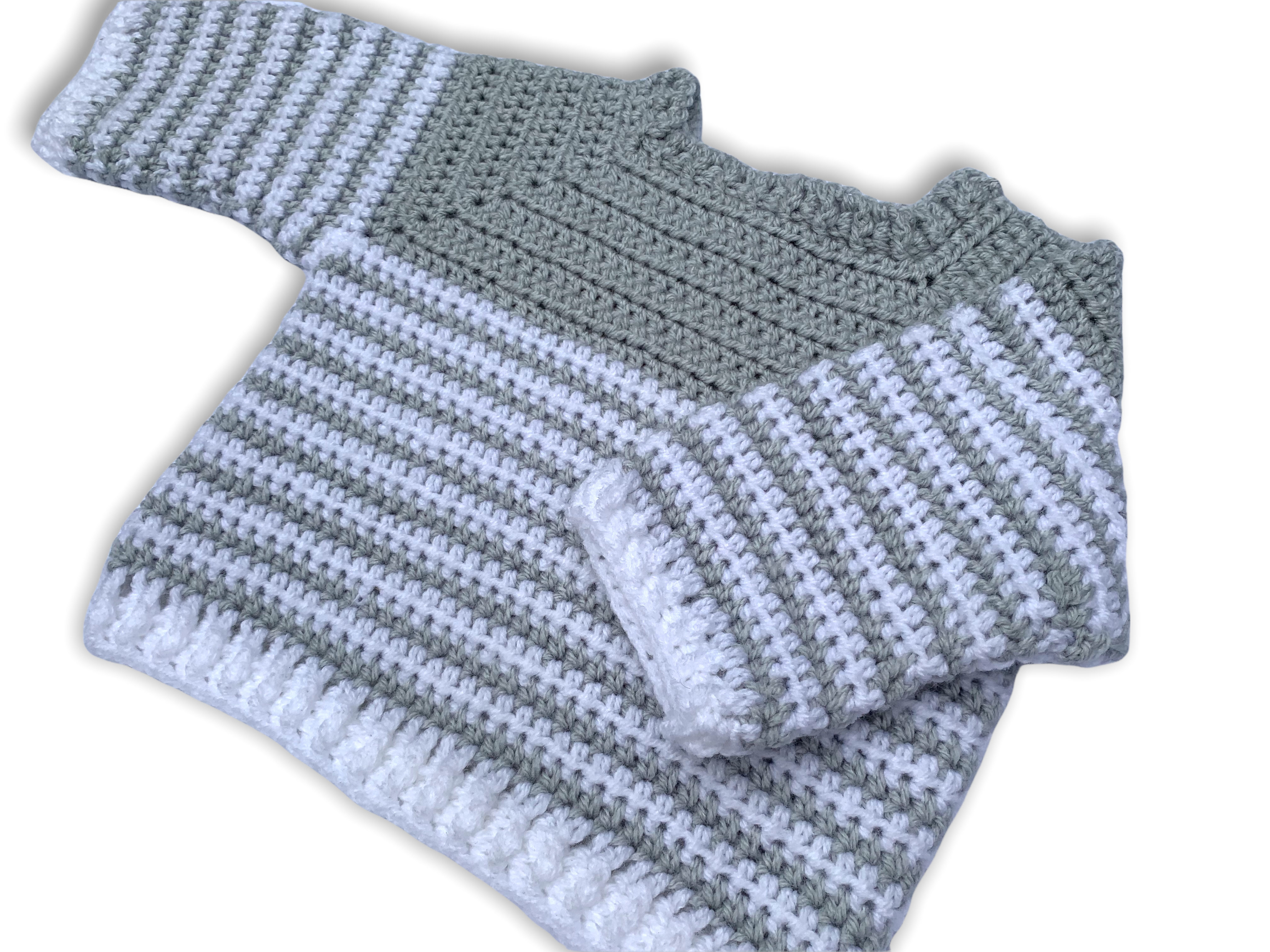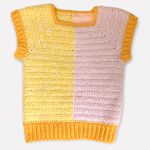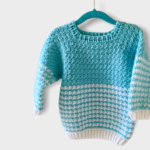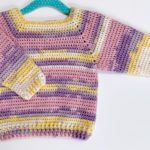Henry is a sweater suitable for boys and girls. It’s worked top-down in one piece, and designed in two colours: the yoke worked in the primary colour and horizontal stripes throughout the rest of the garment. The ribbing at the wrist and hem is worked in the contrast colour.
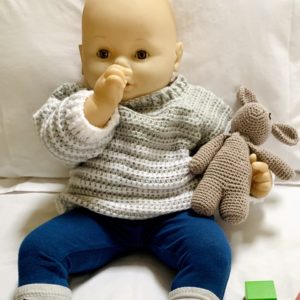
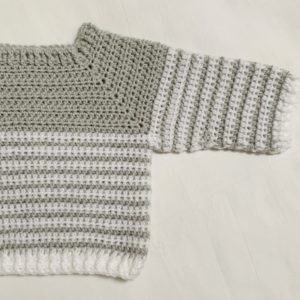
It’s a modern design, worn here by our very accommodating model, Miss Jemima.
This was the first baby sweater I made in this style. I designed it to fit Miss Jemima pictured above, who has the textbook measurements of a three-month-old baby. You can see it’s quite a generous fit for her. I wanted to provide extra room to grow so it could get maximum wear. The actual measurements I achieved for the finished garment are set out here:
| Neck circumference: | 32 cm | 12.5″ |
| Chest (laid flat) | 27 cms | 10.5″ |
| Armhole depth | 10 cms | 4″ |
| Sleeve length from underarm | 15 cms | 5″ |
| Garment length from shoulder | 27 cms | 10.5″ |
| All measurements are approximate |
I gifted this finished sweater to a young family member who’s worn it often. Even at about 18 months, the width in the body, the armhole depth and neck circumference were still adequate.
But by that stage, although the sweater was still mostly fitting well, the arms and the body had become a little short. So I was delighted to simply undo the ribbing on the sleeves and the bottom hem, and extend the garment by a few inches in the sleeves and body to give it some more life throughout the chilly winter months. (Luckily I had a little of the same yarn remaining in my stash.)

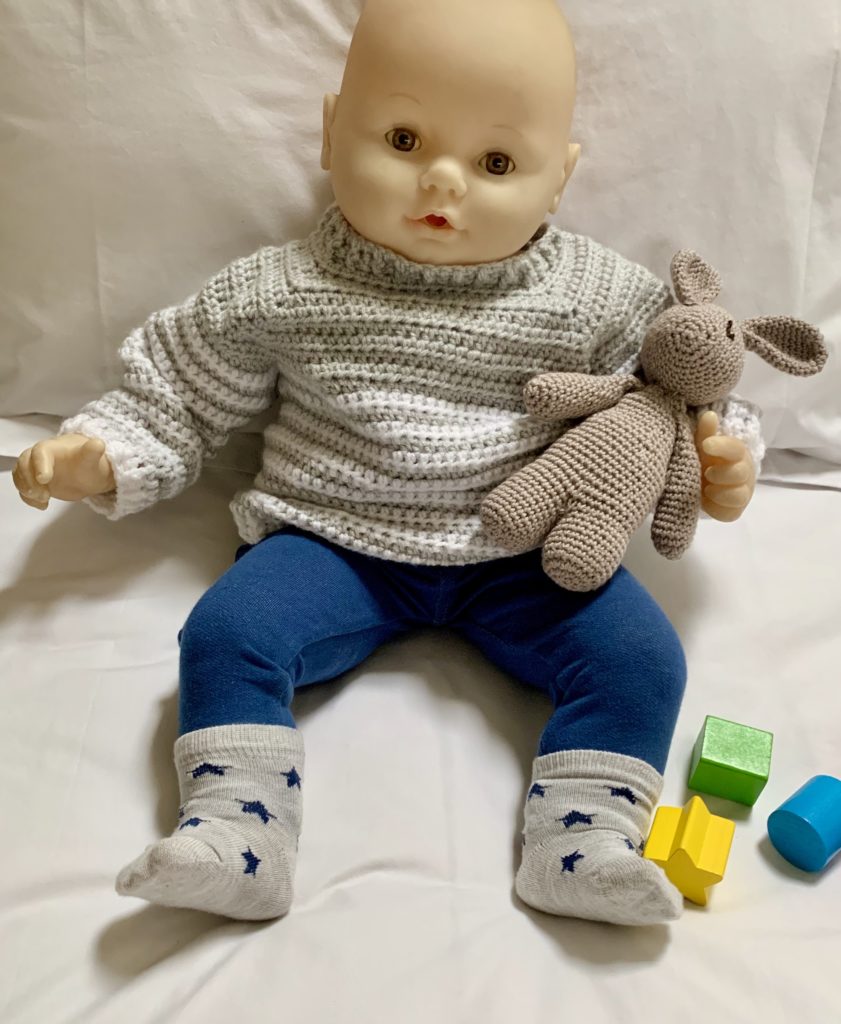
So it seems to me that with its generous fit, this baby sweater could be worn for quite some time beyond the three months I had in mind originally.
If you’re interested in making one too, here’s what I did:
Notes & Instructions for Approx 3 Months
Materials Used
- Crochet Hooks: 5 mm (H), 4.5 mm (7)
- DK yarn (Light Worsted / Weight 3 / 8 ply) in two colours: Main Colour (MC) and Contrast Colour (CC)
- Stitch Markers (I used five: four for the increase points and one for the join at centre back & sleeves)
- Tapestry Needle for weaving in ends
- Scissors
- Tape measure or ruler
Skill Level
The pattern is designed with the intermediate crocheter or experienced beginner in mind. It’s not complicated, but requires knowledge of colour changes, increases and decreases, front and back post stitches.
Yardage
I’m afraid I didn’t record the weight of the finished sweater but based on other similar ones I’ve made, I believe a total of 150g (450 m / 490 yards) of DK yarn should be adequate. More will be required of the Main Colour than the Contrast Colour.
Abbreviations
These notes use US terminology
| ch | chain |
| sc | single crochet |
| dc | double crochet |
| hdc | half double crochet |
| st(s) | stitch(es) |
| sl st | slip stitch |
| hdc[#]tog | half double crochet [#] stitches together |
| sk | skip |
| BPdc | back post double crochet |
| FPdc | front post double crochet |
| WS | wrong side |
| MC | main colour |
| CC | contrast colour |
| SM | stitch marker |
| Rnd(s) | round(s) |
Gauge
Taken from finished garment. Using 5.0 hook.
12 rows, 15 stitches of the pattern = 10 cms x 10 cms (4″ x 4″).
Pattern Notes
- Ch1 at the beginning of a round does not count as a stitch.
- This sweater is worked from the top down in one piece. The sleeves are then added on either side. Sleeves may be worked in the round or if preferred worked flat and seamed together later. Pattern assumes they will be worked in the round.
- Changing Colours: Always change colour when completing the final step of the current colour. At the final step, pull through and finish the stitch with the new colour, then proceed to the next round with the new colour. Drop the first colour to the inside of the garment, ready to pick up again at the end of the round.
My Process
Sizing
Here are the steps I followed.
I started with a target neck measurement of about 32 cms (12.5”) so that when stretched it would go over baby’s head comfortably, but wasn’t too loose around the neck when worn. I created a chain of 32 cms, which was 54 chains.
Getting Started
The yarn I used for this project was a DK acrylic yarn and a size 5 mm hook. This hook is larger than that recommended on the band for this yarn (recommended is 4 mm) but I like the extra drape I get when going up a hook size or two.
So, first: foundation chain of 54, and then place SM as follows (where the first chain is number 1): #9, #19, #36, #46, as per table below:
| Corner | 1 | 2 | 3 | 4 | ||||||
| Section | A Back 1 | Inc | B Shoulder 1 | Inc | C Front | Inc | D Shoulder 2 | Inc | E Back 2 | |
| Chains | 8 | 1 | 9 | 1 | 16 | 1 | 9 | 1 | 8 | = 54 |
| Stitch Markers | SM #9 | SM #19 | SM #36 | SM #46 |
Next, sl st to join and create a circle, ensuring there are no twists. Total ch: 54. Now we are ready to begin the yoke.
Yoke
Rnd 1: Ch 1, and start by working 1 hdc into the next ch. (I always put a SM here in my first full stitch to make life easier when finishing & joining the round.) Continue around, working 1 hdc into each ch except for the marked stitches where we work 3hdc. These four marked stitches will form the corner of the neck (see diagram below). After working the 3hdc, replace the SM into the middle st of the three hdc just worked. After the 4th corner, continue working 1hdc into each ch until the end of the rnd. The final st will go into the base of the ch1 from the beginning of the rnd, here and throughout. Join by sl st to the first hdc of the rnd. Total sts: 62.
Please see the diagram below to see how the yoke is formed.
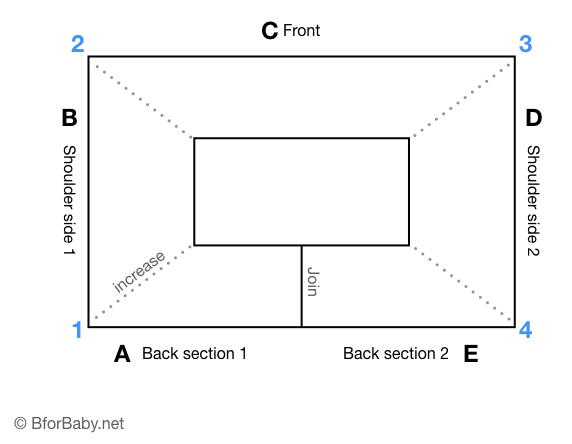
As we see from the diagram, the marked stitches will form the corners of the neck (points 1, 2, 3, 4 in the diagram) and create the raglan-style yoke. In every round of the yoke, we put 3hdc into every marked st and then immediately afterwards move the SM up to the middle st of the three hdc we have just worked. Thus we add 8 sts in every increase rnd.
Next Rnds: Ch1 and turn. Now, we continue in the same manner as Rnd 1 until we reach the required chest width and armhole depth. This means measurement C should be around 25 cms (10”) and measurements B and D should be double the required armhole depth, i.e. around 20 cms (8”).
💡 It’s a good idea in this stage to keep checking that measurements B and D are equal, that A and E are equal, and that A + E together equals C.
If you like to count stitches as you go along, simply check that you have added 8 extra hdc for each rnd.
Rnd 10: Check measurements. Assuming measurements are now as expected, complete rnd 10 in the same way as for previous rnds, now changing yarn to CC on the final pull-through of the final st. Having pulled through with CC, drop MC to the inside (WS) of the garment, ready to pick up again at the end of rnd 11.
Divide for Sleeves & Body
Rnd 11: Ch1 and turn. Using CC, work 1 hdc in each st along, until reaching the first marked corner st (corner 1). Work 2hdc into the corner st, ch1, sk all sts until the next marked st, work 2hdc into that marked corner st, hdc in every st along to corner 3, and then repeat the joining method to join corners 3 and 4; continue with hdc in CC to the end of the rnd. At the end of rnd 11, sl st to join and pull through with MC to change colour. Drop CC to the WS of garment, ready to pick up again when needed.
Body
Rnd 12: Ch1 and turn. With MC, work 1hdc in every hdc all around, including working hdc evenly into the sts and chains in underarm area; sl st to join and pull through with CC.
Rnd 13: Ch1 and turn. With CC, work 1 hdc in every hdc around, joining to first hdc with sl st, completing the round by pulling through with MC.
Next Rnds: Now repeat previous rnds, continuing to alternate between rounds of MC and CC, working even until the work measures 3 cms (1¼”) less than the desired finished garment length. End on MC round.
I achieved this at rnd 26. If a longer sweater is desired, these alternating rnds can be continued.

Bottom Hem Ribbing
Ribbing is worked in CC. Complete the previous rnd by switching to CC, and then cut and fasten off MC yarn. I like to switch to one hook size smaller, to 4.5 mm, so that the ribbing gathers in slightly, to keep baby snug.
Rnd 27: Ch1 and turn. Using CC and hook 4.5 mm, 1 dc in every st around. At the end of the rnd, join with a sl st to the first dc of the rnd.
Rnd 28: Ch1 and turn. Check you have an even number of sts and adjust if necessary. Still using CC, alternate FPdc and BPdc all around to create the bottom hem ribbing.
Continue ribbing until sweater reaches desired length. I completed a total of 3 rnds of ribbing in my CC, but this can be increased according to personal taste. When ribbing is complete, fasten off and cut yarn, leaving a tail long enough for weaving in.
Sleeves
Rnd 1: Using hook 5.0 mm and CC, join yarn in the centre st of the underarm chains. Be sure to work in the right direction, as if you had just turned your work. Work evenly around, working 1hdc in every st around the armhole, including underarm chains; sl st to first hdc to join. Before completing the sl st, pull through with MC.
At this point, count the number of stitches around the armhole, as you will need to replicate this on the other side.
Rnd 2: Ch1 and turn. Work 1hdc in every stitch around until the last 2 sts. hdc2tog in the final two sts, sl st to join, changing back to CC.
Next Rnds: These previous two rnds are then repeated, working hdc2tog at the end of each rnd until the number of sts around is approximately 32. If you have an actual garment of your wearer to refer to for sleeve width, so much the better.
Once you’ve decreased to the desired sleeve width, continue to work even, alternating between MC and CC until the length of the sleeve from the underarm is 3 cm (1¼”) less than the desired finished sleeve length.
Sleeve Ribbing
With hook size 4.5mm, repeat the process used for the Bottom Hem ribbing then fasten off and cut CC yarn, leaving a tail long enough for weaving in. Repeat for the other sleeve.
Neck Ribbing
Preparation: Before beginning, quickly check the neck circumference of your garment to see how it’s responded after being handled. If it has stretched a bit and needs tightening up, consider working one additional rnd with MC, working 1hdc into every st except for the corners where hdc3tog may be helpful. If no tightening is required, proceed to Neck Ribbing Rnd 1.
Rnd 1: With hook size 4.5mm, join MC at centre back, ch1, work 1dc into the next st and in every st around. Complete the rnd with a dc into the base of the ch1 you made at the beginning of the rnd, then sl st to the first dc to join.
Next Rnd: Ch1 and turn. Follow the same process as for the Bottom Hem ribbing, alternating FPdc and BPdc. One round of alternating FPdc and BPdc may be sufficient.
Finishing
Weave in all ends.
💡 I then like to wash the garment and check it over again for problems or loose ends, before gifting.
Wrapping Up
I hope you’ve found these notes helpful, and I hope you enjoy creating beautiful garments for people you love as much as I enjoyed the process of pulling this together.
As I’m sharing my personal notes here for free, this pattern has not been professionally tested or edited. So if you find any errors here or have any thoughts or questions, please do drop me a note using the Contact Form. and I’ll get back to you as soon as I can.
Thank you so much for dropping by 🙂
Debra
© 2020-22 B for Baby. All rights reserved. For terms of use, please see here.
The pattern has been worked up in a number of sizes, and the other sizes will be published here as soon as I get a moment to get it written up in full. If you’d like to know when this post has been updated, subscribe below and the post update will trigger an automatic email to you 🙂

